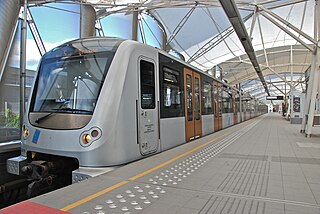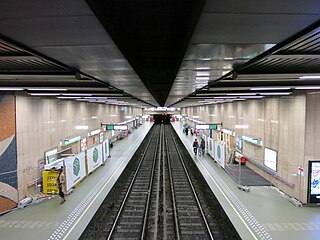
The Brussels Metro is a rapid transit system serving a large part of the Brussels-Capital Region of Belgium. It consists of four conventional metro lines and three premetro lines. The metro-grade lines are M1, M2, M5, and M6 with some shared sections, covering a total of 39.9 kilometres (24.8 mi), with 59 metro-only stations. The premetro network consists of three tram lines that partly travel over underground sections that were intended to be eventually converted into metro lines. Underground stations in the premetro network use the same design as metro stations. A few short underground tramway sections exist, so there is a total of 52.0 kilometres (32.3 mi) of underground metro and tram network. There are a total of 69 metro and premetro stations as of 2011.

The Brussels tramway network is a tram system serving a large part of the Brussels-Capital Region of Belgium. It is the 16th largest tram system in the world by route length, in 2017 providing 149.1 million journeys over routes 140.6 km (87.4 mi) in length. In 2018, it consisted of 18 tram lines. Brussels trams are operated by STIB/MIVB, the local public transport company.

Parc (French) or Park (Dutch) is a Brussels Metro station on lines 1 and 5. It is located under Brussels Park in central Brussels, Belgium. It has one entrance, at the intersection of the Rue Royale/Koningsstraat and the Rue de la Loi/Wetstraat, two of the main roads of the City of Brussels.

Arts-Loi (French) or Kunst-Wet (Dutch) is a Brussels Metro station on lines 1, 2, 5 and 6. It is located in the City of Brussels, Belgium, under the intersection of the Rue de la Loi/Wetstraat and the Avenue des Arts/Kunstlaan, after which it is named, the latter street being part of the Small Ring.

Heysel (French) or Heizel (Dutch) is a Brussels Metro station on the northern branch of line 6. It is located in Laeken, in the north-west of the City of Brussels, Belgium, and serves the Heysel/Heizel Plateau, famous for the World's Fairs of 1935 and 1958, the King Baudouin Stadium and the Atomium. The Bruparck entertainment park and the Centenary Palace, home to the Brussels Exhibition Centre, are also located nearby.

King Baudouin is a Brussels Metro station serving as the northern terminus of line 6. It is located in Laeken, in the north-west of the City of Brussels, Belgium, and serves the King Baudouin Stadium.

Stuyvenbergh is a Brussels Metro station on the northern branch of line 6. It is located under the intersection of the Avenue Houba De Strooper/Houba De Strooperlaan, the Avenue Émile Bockstael/Émile Bockstaellaan and the Avenue De Smet De Naeyer/De Smet De Naeyerlaan, in Laeken, in the north-west of the City of Brussels, Belgium. The station takes its name from the Château of Stuyvenberg, which is just to the east, in Laeken Park.

Bockstael is a Brussels Metro station on the northern branch of line 6. It is located in Laeken, in the north-west of the City of Brussels, Belgium. The station received its name from the aboveground square Place Émile Bockstael/Émile Bockstaelplein, itself named after the liberal politician and former mayor of Laeken, Émile Bockstael.

Beekkant is a Brussels Metro station on lines 1, 2, 5 and 6. It is located under the Boulevard Edmond Machtens/Edmond Machtenslaan in the municipality of Molenbeek-Saint-Jean, in the western part of Brussels, Belgium. The station's name translates into English as "Brookside".

Porte de Hal or Hallepoort (Dutch) is a rapid transit station in Brussels, Belgium, consisting of both a metro station and a premetro station. The station is located in the municipality of Saint-Gilles, south of the City of Brussels, under the Small Ring and next to the 14th-century Halle Gate, after which it is named. It is one metro stop away or about ten minutes' walk from Brussels-South railway station.

Delacroix is a Brussels Metro station on lines 2 and 6. It is located in the municipality of Anderlecht, in the western part of Brussels, Belgium. It is an elevated station, running parallel to the Rue Léon Delacroix/Léon Delacroixstraat, and forming a bridge-viaduct over the Brussels–Charleroi Canal, with entries and exits leading to and from both banks of the canal. The station takes its name from that nearby street, itself named after Léon Delacroix, Belgium's 22nd Prime Minister.

Hôtel des Monnaies (French) or Munthof (Dutch) is a Brussels Metro station on the southern segment of lines 2 and 6. It is located under the Small Ring, near Saint Peter's Hospital, in the municipality of Saint-Gilles, south of the City of Brussels, Belgium. One of its entrances is on the Rue de l'Hôtel des Monnaies/Munthofstraat, after which it is named, and where Belgian currency used to be minted.

Porte de Namur or Naamsepoort (Dutch) is a Brussels Metro station on the southern segment of lines 2 and 6. It is located under the Small Ring at the Square du Bastion/Bolwerksquare, next to the Chaussée d'Ixelles/Elsense Steenweg, in the municipality of Ixelles, south of the City of Brussels, Belgium. The station takes its name from the Namur Gate area, itself named after the Namur Gate in Brussels' old city walls.

Trône (French) or Troon (Dutch) is a Brussels Metro station on the southern segment of lines 2 and 6. It is located under the Small Ring at the Place du Trône/Troonplein, near the Royal Palace, in the City of Brussels, Belgium.

Yser (French) or IJzer (Dutch) is a Brussels Metro station on the northern segment of lines 2 and 6. It is located under the Small Ring, between the Place de l'Yser/IJzerplein and the Porte d'Anvers/Antwerpsepoort, in the City of Brussels, Belgium. The station takes its name from that aboveground square, itself named after the river Yser.
The Brussels tram route 23 was a Brussels tram route operated by STIB/MIVB in Brussels, Belgium. It ran between Vanderkindere, which was also the terminus for tram route 24 and where passengers could commute with tram routes 3, 4 and 92, and the Heysel/Heizel metro station, which offers transit with the Brussels metro line 6, tram route 51 and bus routes 84 and 88. Since March 14, 2011 the newly formed tram 7 follows the same route as tram 23, but with a much higher frequency. Because of the frequency being brought up to 'metro' level, its line number was altered to the lower regions, for those are the metro and so-called 'Chrono' tramlines. Tram 24 was also taken over completely by the newly formed tram 7.

Tram route 81 in Brussels, Belgium, is a tram route operated by STIB/MIVB, which connects the Marius Renard stop in the municipality of Anderlecht with the multimodal Montgomery metro station in Woluwe-Saint-Pierre. The route also crosses the municipalities of Saint-Gilles, Ixelles, the City of Brussels and Etterbeek. It connects with the Metro at Saint-Guidon/Sint Guido, Brussels-South, Merode and Montgomery. The route also crosses the major tram routes 3 and 4 at Horta. A good deal of its length is in carriageway, while long sections at either end are in reservation. It has a short section in tunnel at Brussels-South.

The tram route 51 in Brussels, Belgium, is a tram route operated by STIB/MIVB, which connects Heysel/Heizel metro station in the City of Brussels to the Van Haelen stop in the municipality of Uccle. The route runs north–south, crossing the City of Brussels, Jette, Molenbeek-Saint-Jean, the City of Brussels again, Saint-Gilles, Forest and Uccle. Currently, service is interrupted between Brussels-South railway station and Altitude Cent/Hoogte Honderd due to construction work at Albert premetro station.

Line 5 is a rapid transit line on the Brussels Metro in Belgium operated by STIB/MIVB. It connects Herrmann-Debroux in the south-east of Brussels to Erasme/Erasmus in the south-west via the city centre. It has existed in its current form since 4 April 2009, when the section of former line 1A between Beekkant and Roi Baudouin/Koning Boudewijn was replaced by the section of former line 1B between Beekkant and Erasme. Starting from Herrmann-Debroux, the line crosses the municipalities of Auderghem, Etterbeek, City of Brussels, Molenbeek-Saint-Jean, Koekelberg and Anderlecht. It serves 28 metro stations and has a common section with line 1 between Gare de l'Ouest/Weststation and Merode, and with lines 2 and 6 between Gare de l'Ouest and Beekkant. At Arts-Loi/Kunst-Wet, the line also connects with lines 2 and 6. Railway connections are possible at Brussels-Central, Brussels-Schuman, Merode and Brussels-West.

The premetro and tram route 7 in Brussels, Belgium, is a tram route operated by STIB/MIVB, which connects the Vanderkindere stop in the southern municipality of Uccle with the Heizel/Heysel stop in Laeken in the City of Brussels, where connecting services of tram route 51, Metro line 6, as well as bus routes 84 and 88 depart. The colour of the signage for this line is bright yellow.



















